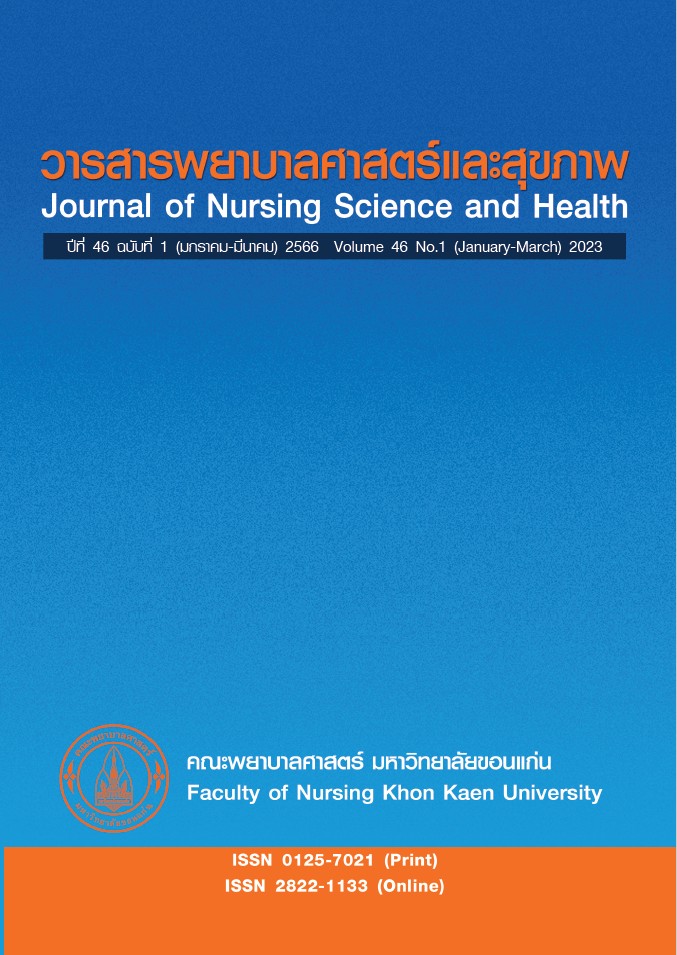ความชุกและปัจจัยที่สัมพันธ์กับอาการปวดกล้ามเนื้อและกระดูกระหว่างการจัดการเรียนการสอนแบบออนไลน์ในนักศึกษาพยาบาลศาสตร์ มหาวิทยาลัยแห่งหนึ่ง
คำสำคัญ:
กล้ามเนื้อและกระดูก , การเรียนออนไลน์ , นักศึกษาพยาบาลศาสตร์ , อาการปวดบทคัดย่อ
ในช่วงที่มีการระบาดของโรคติดเชื้อไวรัสโคโรนา 2019 ทำให้การเรียนของนักศึกษาต้องเปลี่ยนเป็นรูปแบบออนไลน์อย่างหลีกเลี่ยงไม่ได้ ซึ่งอาจส่งผลให้เกิดความปวดเมื่อยตามร่างกาย การศึกษาเชิงพรรณนาภาคตัดขวางนี้มีวัตถุประสงค์เพื่อศึกษาความชุกและปัจจัยที่สัมพันธ์กับอาการปวดกล้ามเนื้อและกระดูกระหว่างการจัดการเรียนการสอนแบบออนไลน์ในนักศึกษาพยาบาลศาสตรบัณฑิต มหาวิทยาลัยแห่งหนึ่ง กลุ่มตัวอย่างคือนักศึกษาพยาบาลศาสตร์ ชั้นปีที่ 1-4 จำนวน 221 คน เก็บข้อมูลโดยใช้แบบสอบถามออนไลน์ ประกอบด้วยแบบสอบถามข้อมูลส่วนบุคคลทั่วไป แบบสอบถามปัจจัยเสี่ยงจากการเรียนการสอนออนไลน์ และแบบสอบถามการประเมินอาการผิดปกติกลุ่มอาการทางระบบกระดูกและกล้ามเนื้อ ดำเนินการเก็บรวบรวมข้อมูลระหว่างเดือนพฤษภาคม-มิถุนายน 2565 วิเคราะห์ข้อมูลโดยใช้สถิติเชิงพรรณนาและวิเคราะห์ปัจจัยที่มีความสัมพันธ์กับระดับความปวดโดยใช้การวิเคราะห์ถดถอยพหุนาม
ผลการศึกษาพบว่ากลุ่มตัวอย่างมีอายุเฉลี่ย 20.24 ปี (S.D. 1.24) ใช้เวลาในการนั่งทำงานหรือเรียนออนไลน์เฉลี่ย 7.10 ชั่วโมง/วัน (S.D. 2.54) ส่วนใหญ่เป็นเพศหญิง (ร้อยละ 91.86) มีการนั่งติดต่อกันมากกว่า 3 ชั่วโมง (ร้อยละ 91.40) มีเพียงร้อยละ 50 ที่มีการพัก จำนวน 1-2 ครั้ง ด้านอุปกรณ์การเรียนออนไลน์ ร้อยละ 46.15 ใช้แท็บเล็ตไม่มีคีย์บอร์ดแยกเป็นอุปกรณ์หลัก ขณะที่เกือบหนึ่งในห้า (39.37%) เรียนออนไลน์หรือทำงานผ่านโทรศัพท์มือถือ ส่วนใหญ่มีอาการปวดกล้ามเนื้อและกระดูกในระยะ 6 เดือน (ร้อยละ 72.40) ตำแหน่งที่ปวดมากที่สุดคือ หลัง คอ และไหล่ตามลำดับ มีค่าเฉลี่ยระดับคะแนนความปวดจาก 0–10 คะแนนเป็น 3.54 คะแนน (S.D. 2.74) ร้อยละ 21 มีอาการปวดซ้ำ ๆ อย่างต่อเนื่อง ร้อยละ 68.67 คิดว่าอาการปวดเกิดจากท่าทางการนั่งหรือการนั่งเป็นระยะเวลานาน และพบว่าการนั่งท่าเดิมเป็นระยะเวลานานมีความสัมพันธ์กับระดับความปวดอย่างมีนัยสำคัญทางสถิติ (p-value 0.02)
ผลการวิจัยครั้งนี้ แสดงให้เห็นถึงผลกระทบการเรียนออนไลน์ต่ออาการปวดกล้ามเนื้อและกระดูกของนักศึกษาพยาบาล รวมทั้งปัจจัยที่เกี่ยวข้องคือการนั่งท่าเดิมเป็นเวลานาน ซึ่งสถาบันการศึกษาสามารถใช้เป็นข้อมูลเพื่อออกแบบแนวทางในการจัดการเรียนการสอนออนไลน์ที่เหมาะสมเพื่อลดผลกระทบที่เกิดขึ้นต่อไป
เอกสารอ้างอิง
World Health Organization. WHO Coronavirus (COVID-19) dashboard [Internet]. Geneva: WHO; 2022. Available from https://covid19.who.int/
Ministry of Public Health. Overview of the COVID-19 infection situation in Thailand on September 17, 2022 [Internet]. Nonthaburi: Ministry of Public Health; 2565. Available from https://ddc.moph.go.th/covid19-dashboard/ (in Thai)
Sharma D, Kafle R, Singh S. E-learning during COVID-19 pandemic: Attitude and problems faced by the nursing student. Journal of Chitwan Medical College 2021;11(38):93-7.
Vanichanan P. Basic education in the era of COVID-19: How will schools open or close? [Internet]. Bangkok: Thailand Development Research Institute; 2020a [cited 2022 Sep 17]. Available from: https://tdri.or.th/2020/05/basic-education-in-covid-19-crisis-reopening-school-after-lockdown (in Thai)
Trakulkasemsuk P, Phanomsarnnarin N, Yodsai T, Wongsakul S. A causal relationship model of online learning on secondary school students' low back pain. Journal of MCU Social Science Review 2021;10(3):26-38. (in Thai)
Lertsinthai P, Nontakoot J, Toudkavinkul N, Weerachai A, Weeraphan O. The prevalence of neck pain and the relationship between neck pain and computer vision syndrome in Faculty of Allied Health Sciences students at Naresuan University. Thai Journal of Physical Therapy 2020;42(2):101-17. (in Thai)
Tongdi N, Inwan C, Proytong S, Kaewlomkai J, Deepong C, Choochouy N. Muscle pain and risk factors of muscle pain during the online learning and working from home among the students and staffs of Faculty of Public Health, Thammasat University, Lampang Campus. Thai Journal of Ergonomics 2021;4(1):47-57. (in Thai)
Prasitthimet T, Sittirit S, Sangpaew K, Phromsoonthorn S, Saentalad J. Behavior and effect using smartphones learning in online of nursing students during epidemic of Novel Corona Virus 2019. Journal of MCU Social Science Review 2022;7(1):348-58. (in Thai)
Singh S, Saini A, Ahlawat TR. Impact of online teaching on health of university students during COVID-19 pandemic crisis. Pharma innov 2021;10(4):958-61.
Yaseen QB, Salah H. The impact of e-learning during COVID-19 pandemic on students’ body aches in Palestine. Sci Rep 2021;11:1-9.
Intolo P. Comparison of muscular pain during smartphone use among three age groups: elementary school student, high school student and office worker. Journal of Health Systems Research 2018;12(2):328-41. (in Thai)
Intolo P, Plangsiri K. Effect of posture during tablet use on pain and muscle activity in office workers. Journal of Sports Science and Health 2019;20(1):73-87. (in Thai)
Wang YX, Wang JQ, Kaplar Z. Increased low back pain prevalence in females than in males after menopause age: Evidence based on synthetic literature review. Quant Imag Med Surg 2016;6:199–206.
Faculty of Nursing, Khon Kaen University. Student timetable for Bachelor of Nursing program, second semester of academic year 2021. Khon Kaen: Faculty of Nursing, Khon Kaen University; 2021. (in Thai)
Chaimay B. Sample size determination in descriptive study in public health. Thaksin University Journal 2013;16(2):9-18. (in Thai)
LaRose R, Tsai H-yS. Completion rates and non-response error in online surveys: Comparing sweepstakes and pre-paid cash incentives in studies of online behavior. Comput Hum Behav 2014;34:110-9.
Bureau of Occupational and Environmental Diseases. 2014. Report of situation of occupational and environmental diseases [Internet]. Retrieved August 28, 2016. Available from: http://envocc.ddc.moph.go.th/ (in Thai)
Kliger M, Stahl S, Haddad M, Suzan E, Adler R, Eisenberg E. Measuring the intensity of chronic pain: Are the visual analogue scale and the verbal rating scale interchangeable. Pain Pract 2015;15(6):538-47.
Chanthawat S, Aungudornpukdee P. Prevalence and factors affecting musculoskeletal disorders among farmers in Wang thong District of Phitsanulok province. The Southern College Network Journal of Nursing and Public Health 2021; 8(3): 318-28. (in Thai)
Muangiaiphet P, Suggaravetsiri, P, Prevalence and factors associated with melioidosis in Ubon Ratchathani province. Journal of the Office of DCP 7 Khon Kaen 2019;26(2):1-13. (in Thai)
Thorburn E, Pope R, Wang S. Musculoskeletal symptoms among adult smartphone and tablet device users: a retrospective study. Arch Physiother 2021;11(1):1-13.
Khruakhorn S, Kanchanomai S. Prevalence and risk factors associated with neck pain from smartphone use in the Khlong-Luang secondary school students. Thai Journal of Physical Therapy 2016;38(23):22-8. (in Thai)
Salameh MA, Boyajian SD, Odeh HN, Amaireh EA, Funjan KI, Al-Shatanawi TN. Increased incidence of musculoskeletal pain in medical students during distance learning necessitated by the COVID-19 pandemic. Clin Anat 2022;35(4):529–36.
Kwon Y, Kim JW, Heo JH, Jeon HM, Choi EB, Eom GM. The effect of sitting posture on the loads at cervico-thoracic and lumbosacral joints. Tech Health Care 2018;26(1):409–18.
Khanna V, Khanna HC. Musculoskeletal disorders following excessive smartphone usage-a review article. MOJ Orthop Rheumatol 2020;12(4):92-4.
Greig AM, Straker LM, Briggs A. Cervical erector spinae and upper trapezius muscle activity in children using different information technologies. Physiotherapy 2005;19(2):119-26.
Lee S, Kang H, Shin G. Head flexion angle while using a smartphone. Ergonomics 2015;58(2): 220–26.
Eitivipart AC, Viriyarojanakul S, Redhead L. Musculoskeletal disorder and pain associated with smartphone use: A systematic review of biomechanical evidence. Hong Kong physiother J 2018;38(2):77–90.
Binboğa E, Korhan O. Posture, musculoskeletal activities, and possible musculoskeletal discomfort among children using laptops or tablet computers for educational purposes: A literature review. J Sci Educ Technol 2014;23(5):605-16.
Trakulkasemsuk P, Phanomsarnnarin N, Yodsai T. A causal relationship model of online learning on secondary school students’ low back pain. Journal of MCU Social Science Review 2021;10(3):26-38. (in Thai)
Buranru O, Eungpinichpong W, Khonharn K, Ponwapi N, Chintakian P. A survey of musculoskeletal disorder at neck and upper extremities and ergonomics management in computer users. Srinagarind Medical Journal 2018;30(1):29-38. (in Thai)
ดาวน์โหลด
เผยแพร่แล้ว
รูปแบบการอ้างอิง
ฉบับ
ประเภทบทความ
สัญญาอนุญาต
ลิขสิทธิ์ (c) 2023 วารสารพยาบาลศาสตร์และสุขภาพ

อนุญาตภายใต้เงื่อนไข Creative Commons Attribution-NonCommercial-NoDerivatives 4.0 International License.
วารสารพยาบาลศาสตร์และสุขภาพเป็นเจ้าของลิขสิทธิ์ในการเผยแพร่ผลงานที่ตีพิมพ์ห้ามผู้ใดนำบทความที่ได้รับการตีพิมพ์ในวารสารพยาบาลศาสตร์และสุขภาพไปเผยแพร่ในลักษณะต่าง ๆ ดังนี้ การนำบทความไปเผยแพร่ออนไลน์ การถ่ายเอกสารบทความเพื่อกิจกรรมที่ไม่ใช่การเรียนการสอน การส่งบทความไปตีพิมพ์เผยแพร่ที่อื่น ยกเว้นเสียแต่ได้รับอนุญาตจากวารสารพยาบาลศาสตร์และสุขภาพ



